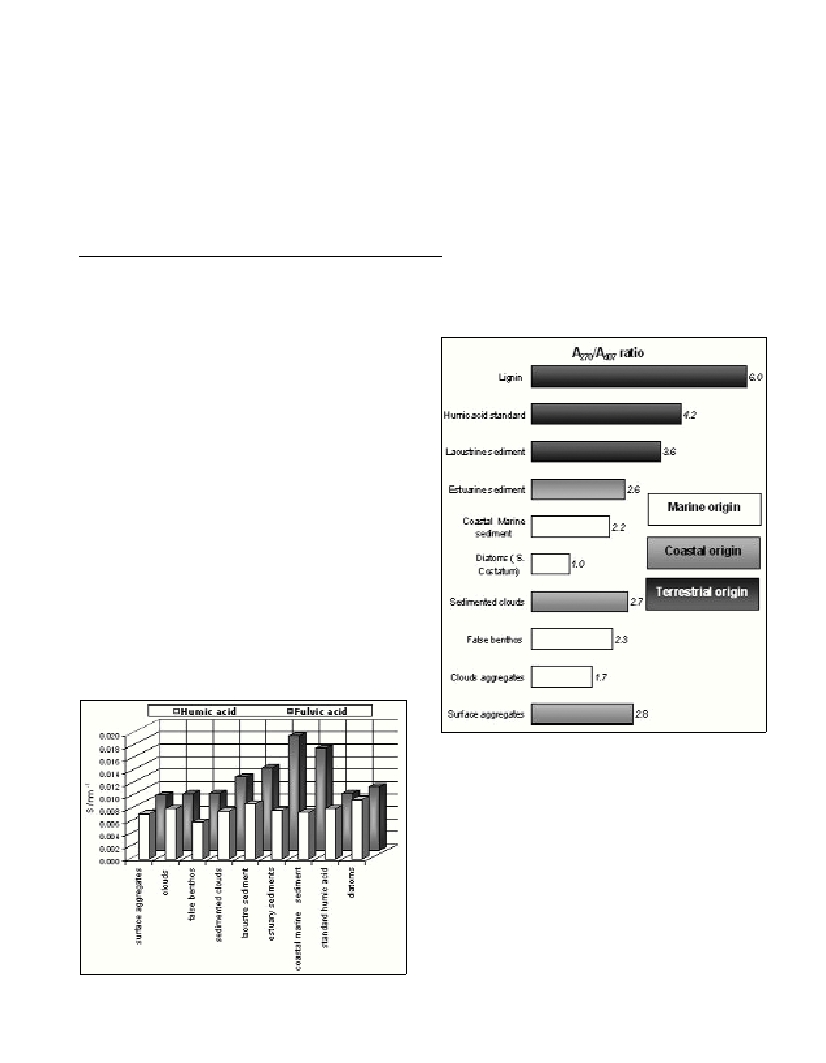THE MARINE ORIGIN OF MUCILAGINOUS AGGREGATES OF THE NORTHERN ADRIATIC
D. Berto, M. Giani*, V. Zangrando, S. Castelli
Istituto Centrale per la Ricerca scientifica e tecnologica Applicata al Mare, Brondolo, 30015 Chioggia,
Italy - *m.giani@icram.org
Abstract
The chemical composition of mucilaginous aggregates sampled during summer 2000, 2001 and 2002 in the North Adriatic Sea was
studied. The aggregates were mainly composed by organic matter and secondarily by inorganic elements. The C
org
/N ratio of the
aggregates changes with their morphology, dimension and age . To investigate nature of organic fraction of the aggregates the extraction
of humic, fulvic and humin fractions substances was carried out. The origin of the humic compounds have been studied by UV-VIS and
FT-IR spectroscopy. The 270/407 nm ratio have been used in order to differentiate the marine and terrestrial humic acids in the aggregates.
In order to differentiate humic acids from fulvic acids the slope of absorption spectra, S, derived by exponential fitting, was measured and
compared to terrigenous and marine sediments.
Keywords: Aggregates, humic acids, Northern Adriatic , UV-VIS spectra
Rapp. Comm. int. Mer Médit., 37,2004
174
The chemical composition of mucilaginous aggregates sampled
during summer 2000, 2001 and 2002 in the North Adriatic Sea
depends on the nature of organic matter during aggregation, on the
environmental conditions of the site of formation and on the
transformations during aging.
The aggregates sampled in the water column were mainly
composed by organic matter and secondarily by inorganic elements.
Elemental analysis indicates 12.5-32.2 % of organic carbon, 0-7.3 %
of inorganic carbon and 1.0-3.7 % of nitrogen. The C
org
/N ratios of
most aggregates are between 7.5 and 12.6, values close to those found
in the suspended matter, higher ratios were found in large size (>5 m)
aggregates which were probably older.
The C
org
/N ratio of aggregates changes with their morphology,
dimension and age in the following sequence: ribbons
?
cob webs
?
false benthos
?
clouds
?
sedimented clouds.
The extraction of humic, fulvic and humin fractions by XAD 2
column allows the characterisation of organic substances constituting
the aggregates. The humin (fraction insoluble in acid and basic media)
was present in all mucilage samples pointing out the refractory nature
of a part of the organic matter.
The humic acids were characterised by the presence in the UV-VIS
spectra of a peak around 407 nm, not present in the terrestrial humic
acids. The 407 nm peak could be due to covalent bond between humic
acids and degradation pigments of chlorophyll, while in those of
terrestrial humic acids the interaction is only adsorptive (1) .
The 270/407 nm ratio can be used in order to differentiate marine
humic acids and terrestrial humic acids in the aggregates . Higher
values of the ratio can be attributed to a terrestrial origin of the humic
acids (1). Terrestrial samples had higher values (>3.4) than marine
ones (<1.9) whereas the coastal humic acids had intermediate values
ranging from 2.4 to 3.1 (Fig. 1). Most part of the Adriatic aggregates
sampled showed a marine origin, in particular the clouds and the false
benthos, while the surface aggregates evidenced a coastal origin due
to higher contribution of organic substances of ?uvial origin.
Fig. 1. Spectral slope of the absorption spectra for humic and fulvic acids
of different origin.
In order to differentiate humic acids and fulvic acids found in the
aggregates the slope of absorption spectra, S, derived by exponential
fitting, was measured and compared to terrigenous and marine
sediments (2). The S for the fulvic acid absorption spectra were nearly
twice as large as those for humic acids (3) (Fig. 2).
Fig. 2. Absorbance ratio A
270
/A
407
for humic fractions extracted by
mucilaginous aggregates and sediments of different origin.
The FT-IR spectra of mucilage and humic fractions showed the
absence of aromatic structures, typical of terrestrial humic acids
(Bottura, pers. Comm.), confirming the marine origin of these
aggregates .
References
1-Fooken U. and Liebetzeit G , 2000. Distinction of marine and
terrestrial origin of humic acids in North Sea surface sediments by
adsorbtion spectroscopy. Mar. Geology, 164: 173-181
2-Zepp R.G. and Sclotzhauer P.F., 1981. Comparison of photochemical
behaviour of various humic substances in water. Spectroscopic properties
of humic substances. Chemosphere,5: 479-486.
3-Carder K.L., Steward R.G., Harvey G.R., and Otner P.B., 1989. Marine
humic and fulvic acids: their effects on remote sensing of ocean
chlorophyll. Limnol. Oceanogr., 34(1): 68-81.

